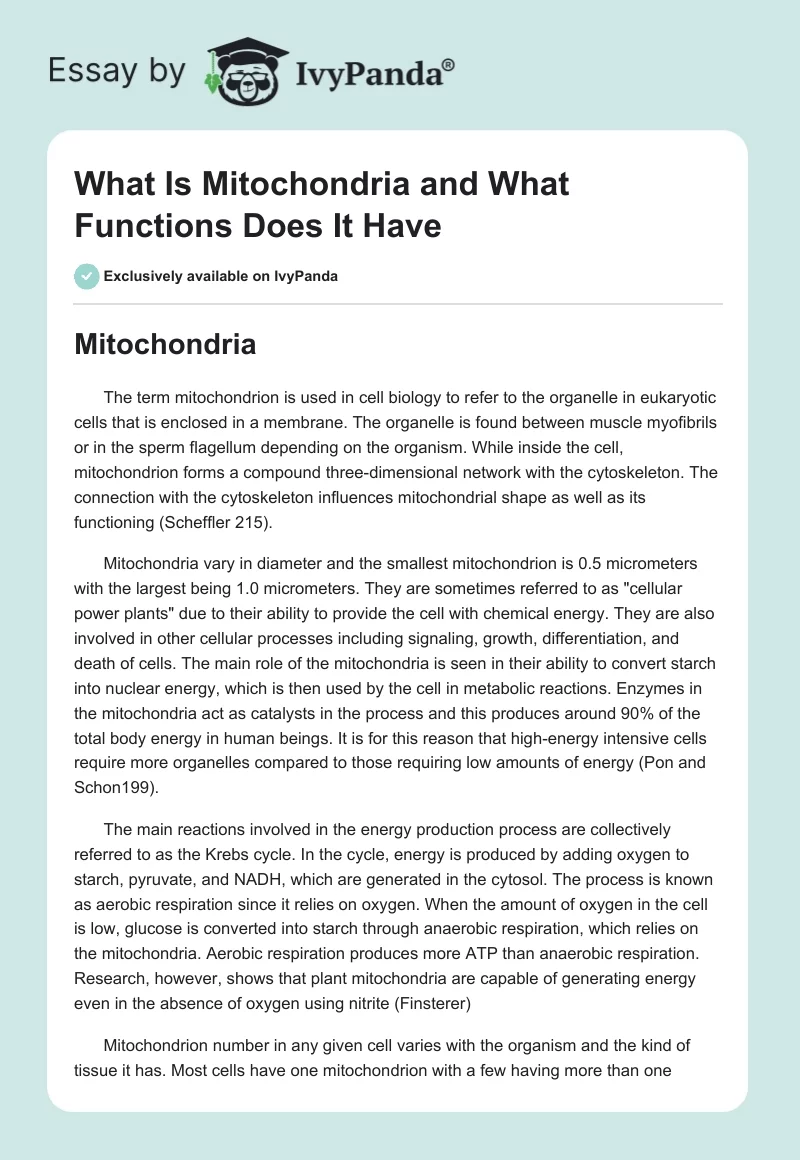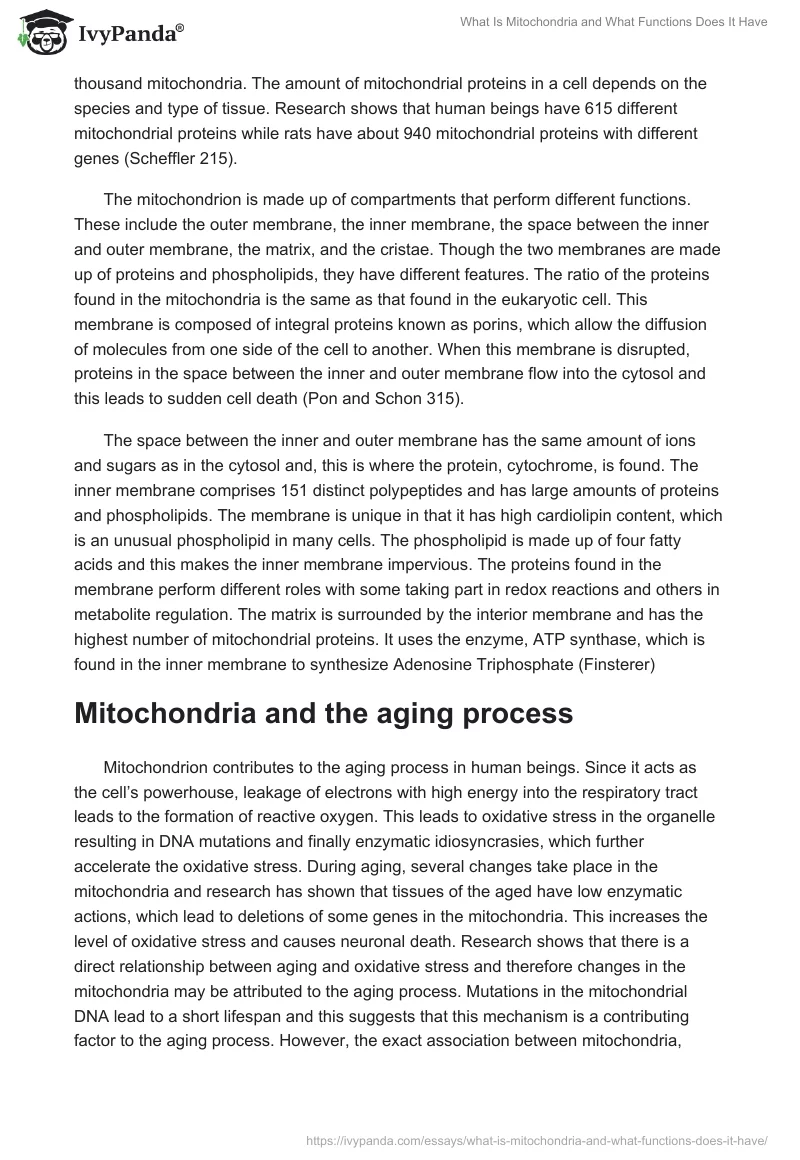Mitochondria
The term mitochondrion is used in cell biology to refer to the organelle in eukaryotic cells that is enclosed in a membrane. The organelle is found between muscle myofibrils or in the sperm flagellum depending on the organism. While inside the cell, mitochondrion forms a compound three-dimensional network with the cytoskeleton. The connection with the cytoskeleton influences mitochondrial shape as well as its functioning (Scheffler 215).
Mitochondria vary in diameter and the smallest mitochondrion is 0.5 micrometers with the largest being 1.0 micrometers. They are sometimes referred to as “cellular power plants” due to their ability to provide the cell with chemical energy. They are also involved in other cellular processes including signaling, growth, differentiation, and death of cells. The main role of the mitochondria is seen in their ability to convert starch into nuclear energy, which is then used by the cell in metabolic reactions. Enzymes in the mitochondria act as catalysts in the process and this produces around 90% of the total body energy in human beings. It is for this reason that high-energy intensive cells require more organelles compared to those requiring low amounts of energy (Pon and Schon199).
The main reactions involved in the energy production process are collectively referred to as the Krebs cycle. In the cycle, energy is produced by adding oxygen to starch, pyruvate, and NADH, which are generated in the cytosol. The process is known as aerobic respiration since it relies on oxygen. When the amount of oxygen in the cell is low, glucose is converted into starch through anaerobic respiration, which relies on the mitochondria. Aerobic respiration produces more ATP than anaerobic respiration. Research, however, shows that plant mitochondria are capable of generating energy even in the absence of oxygen using nitrite (Finsterer)
Mitochondrion number in any given cell varies with the organism and the kind of tissue it has. Most cells have one mitochondrion with a few having more than one thousand mitochondria. The amount of mitochondrial proteins in a cell depends on the species and type of tissue. Research shows that human beings have 615 different mitochondrial proteins while rats have about 940 mitochondrial proteins with different genes (Scheffler 215).
The mitochondrion is made up of compartments that perform different functions. These include the outer membrane, the inner membrane, the space between the inner and outer membrane, the matrix, and the cristae. Though the two membranes are made up of proteins and phospholipids, they have different features. The ratio of the proteins found in the mitochondria is the same as that found in the eukaryotic cell. This membrane is composed of integral proteins known as porins, which allow the diffusion of molecules from one side of the cell to another. When this membrane is disrupted, proteins in the space between the inner and outer membrane flow into the cytosol and this leads to sudden cell death (Pon and Schon 315).
The space between the inner and outer membrane has the same amount of ions and sugars as in the cytosol and, this is where the protein, cytochrome, is found. The inner membrane comprises 151 distinct polypeptides and has large amounts of proteins and phospholipids. The membrane is unique in that it has high cardiolipin content, which is an unusual phospholipid in many cells. The phospholipid is made up of four fatty acids and this makes the inner membrane impervious. The proteins found in the membrane perform different roles with some taking part in redox reactions and others in metabolite regulation. The matrix is surrounded by the interior membrane and has the highest number of mitochondrial proteins. It uses the enzyme, ATP synthase, which is found in the inner membrane to synthesize Adenosine Triphosphate (Finsterer)
Mitochondria and the aging process
Mitochondrion contributes to the aging process in human beings. Since it acts as the cell’s powerhouse, leakage of electrons with high energy into the respiratory tract leads to the formation of reactive oxygen. This leads to oxidative stress in the organelle resulting in DNA mutations and finally enzymatic idiosyncrasies, which further accelerate the oxidative stress. During aging, several changes take place in the mitochondria and research has shown that tissues of the aged have low enzymatic actions, which lead to deletions of some genes in the mitochondria. This increases the level of oxidative stress and causes neuronal death. Research shows that there is a direct relationship between aging and oxidative stress and therefore changes in the mitochondria may be attributed to the aging process. Mutations in the mitochondrial DNA lead to a short lifespan and this suggests that this mechanism is a contributing factor to the aging process. However, the exact association between mitochondria, oxidative anxiety, and the aging process has not yet been established (Packer and Enrique 169).
Diseases of the Mitochondria
Several diseases in human beings have been attributed to mitochondrial dysfunction. Mitochondrial disorders tend to be continuous and do not show symptoms in the initial stages. There are many diseases associated with the mitochondria with those leading to “bad mitochondria” growing extremely in such a way that disease develops. Minor mitochondrial disorders are less virulent and do not show serious symptoms. It is important to note that the degree of infection depends on the cell. For instance, high-energy intensive cells have the largest number of mitochondria and are prone to mitochondrial disorders. Examples of such cells include the brain, cardiac, kidney, and nervous system (Holt 56).
Since the organelle plays a major role in cell metabolism, it is a critical factor when it comes to human disorders. Mitochondrial diseases include those of the nervous system, diabetes, and other systemic disorders. Disorders of the mitochondria caused by changes in the mtDNA include Kearns-Sayre, Melas, and Leber’s Hereditary Optic Neuropathy (LHON). In most cases, these disorders are transmitted from mother to child since the zygote gets its mtDNA from the ova. For instance, it is believed that Kearns-Sayre syndrome is a result of large-scale relocations of the mtDNA whereas Melas, and Leber’s Hereditary Optic Neuropathy (LHON) are caused by point changes in mtDNA. Faults in nuclear genes result in malfunctioning of proteins in the mitochondria and this leads to diseases such as Hereditary Spastic Paraplegia (HSP) and Friedreich’s Ataxia. Other mitochondrial disorders occur as a result of changes in the nuclear oxidative phosphorylation catalysts. Environmental changes may also interact with genetic predispositions to cause mitochondrial disorders. For instance, there is a relationship between exposure to certain chemicals and the onset of Parkinson’s, which is a mitochondrial disorder. It is therefore clear that mitochondrial dysfunction leads to certain disorders in human beings (Holt 56).
Works Cited
Finsterer, Josef. “Hematological manifestations of primary mitochondrial disorders”. Acta Haematol. 118 (2): 88–98. (2007):
Holt, James. Genetics of mitochondrial diseases. Oxford: Oxford University Press, 2003. Print
Packer, Lester and Enrique Cadenas. Understanding the process of aging: the roles of mitochondria, free radicals, and antioxidants. New York: Dekker, 1999. Print.
Pon, Liza and Schon, Eric. Mitochondria. Boston: Academic Press, 2007. Print
Scheffler, Imo. Mitochondria. New York. John Wiley & Sons, 2011. Print.


